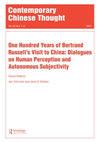二十一世纪的老子研究
IF 0.4
3区 哲学
0 ASIAN STUDIES
引用次数: 1
摘要
《老子》或《道德经》至少两千年来一直是中国关注的对象。最近的一些发现激起了人们的兴趣。20世纪70年代发掘了两个早期汉墓的丝绸手稿,20世纪90年代发现了简牍上的三个前汉文部分。由此产生的学术讨论在各种英语研究中得到了全面的讨论。2009年之后,北京大学从一座汉墓中获得了另一套手稿,引发了新的轰动。它们写在简牍上,分为两部分,名为《经》。很少有学者怀疑它们的真实性。迄今为止,北京大学的《老子》在大多数中国文章中都有讨论。本期《当代中国思想》提供了一个对这一研究的一瞥。它包含四篇文章:王neneneba波(北京大学),陈静(中国社会科学院),廖明春和李成(清华大学),丁思新(清华大学的)。这四种贡献所共有的方法可以大致确定为知识史。它们展示了最近的发现是如何被纳入长期争论的,不仅涉及这一特定文本,还涉及对文本稳定性、不同版本、文本变体、文本与评论之间的关系、标题的性质、作者类型以及文本含义的历史背景等问题的思考。在分别总结文章之前,我们先简要介绍一下它们的背景设置。本文章由计算机程序翻译,如有差异,请以英文原文为准。
Laozi Studies in the Twenty-First Century
The Laozi or Daodejing has been for at least two thousand years an object of keen interest in China. This interest has been stirred by some recent discoveries. Two silk manuscripts from an Early Han tomb were excavated in the 1970s, and three pre-Han portions of the text on bamboo slips were found in the 1990s. The resulting academic discussions have been comprehensively discussed in various English studies. A new stir followed after 2009, when Peking University acquired yet another set of manuscripts from a Han tomb. They were written on bamboo slips and divided into two parts titled jing (Classic). Few scholars have doubted their authenticity. This Peking University Laozi has hitherto been discussed in mostly Chinese articles. This issue of Contemporary Chinese Thought provides a glimpse of this research. It contains four articles: by Wang Bo (Peking University), Chen Jing (Chinese Academy of Social Sciences), Liao Mingchun and Li Cheng (Tsinghua University), and Ding Sixin (Tsinghua University). The approach that these four contributions share can be roughly identified as intellectual history. They show how the recent discoveries are incorporated into age-long debates, not only concerning this particular text, but entailing reflections on such issues as the stability of texts, different editions, textual variants, the relation between text and commentary, the nature of titles, types of authorship, and the historical context of textual meanings. Before summarizing the articles separately, we briefly present their background setting.
求助全文
通过发布文献求助,成功后即可免费获取论文全文。
去求助
来源期刊

CONTEMPORARY CHINESE THOUGHT
Multiple-
CiteScore
0.10
自引率
0.00%
发文量
0
期刊介绍:
This wide ranging journal is essential reading for anyone who wants to understand the diverse themes and influences that shape Chinese thought today. It features translations of the most current and influential Chinese writings on all aspects of philosophical endeavor, from theoretical essays on systems to studies of China"s cultural and religious development, from interpretations of the Chinese classics to exegeses on Marxist thought.
 求助内容:
求助内容: 应助结果提醒方式:
应助结果提醒方式:


